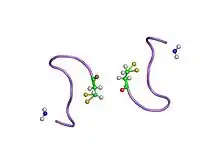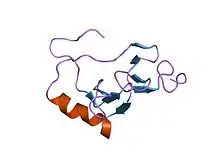Neurohypophysial hormone
The neurohypophysial hormones form a family of structurally and functionally related peptide hormones. Their main representatives are oxytocin and vasopressin. They are named after the location of their release into the blood, the neurohypophysis (another name for the posterior pituitary).
| Neurohypophysial hormones, N-terminal Domain | |||||||||
|---|---|---|---|---|---|---|---|---|---|
 crystal structure analysis of deamino-oxytocin. conformational flexibility and receptor binding | |||||||||
| Identifiers | |||||||||
| Symbol | Hormone_4 | ||||||||
| Pfam | PF00220 | ||||||||
| InterPro | IPR022423 | ||||||||
| PROSITE | PDOC00237 | ||||||||
| SCOP2 | 1xy1 / SCOPe / SUPFAM | ||||||||
| |||||||||
| Neurohypophysial hormones, C-terminal Domain | |||||||||
|---|---|---|---|---|---|---|---|---|---|
 solution structure of the monomeric form of a mutant unliganded bovine neurophysin, minimized average structure | |||||||||
| Identifiers | |||||||||
| Symbol | Hormone_5 | ||||||||
| Pfam | PF00184 | ||||||||
| InterPro | IPR000981 | ||||||||
| PROSITE | PDOC00237 | ||||||||
| SCOP2 | 1xy2 / SCOPe / SUPFAM | ||||||||
| |||||||||
Most of the circulating oxytocin and vasopressin hormones are synthesized in magnocellular neurosecretory cells of the supraoptic nucleus and paraventricular nucleus of the hypothalamus. They are then transported in neurosecretory granules along axons within the hypothalamo-neurohypophysial tract by axoplasmic flow to axon terminals forming the pars nervosa of the posterior pituitary. There, they are stored in Herring bodies and can be released into the circulation on the basis of hormonal and synaptic signals with assistance from pituicytes.[1][2][3]
Oxytocin mediates contraction of the smooth muscle of the uterus and mammary gland, while vasopressin has antidiuretic action on the kidney, and mediates vasoconstriction of the peripheral vessels.[4] Due to the similarity of the two hormones, there is cross-reaction: oxytocin has a slight antidiuretic function, and high levels of AVP can cause uterine contractions.[5][6] In common with most active peptides, both hormones are synthesised as larger protein precursors that are enzymatically converted to their mature forms.
Members of this family are found in birds, fish, reptiles and amphibians (mesotocin, isotocin, valitocin, glumitocin, aspargtocin, vasotocin, seritocin, asvatocin, phasvatocin), in worms (annetocin, nematocin), octopuses (cephalotocin), Locusta migratoria (Migratory locust) (locupressin or neuropeptide F1/F2) and in molluscs (conopressins G and S).[7]
References
- Burbach JP, Luckman SM, Murphy D, Gainer H (July 2001). "Gene regulation in the magnocellular hypothalamo-neurohypophysial system". Physiol. Rev. 81 (3): 1197–267. doi:10.1152/physrev.2001.81.3.1197. PMID 11427695.
- Jones CW, Pickering BT (December 1972). "Intra-axonal transport and turnover of neurohypophysial hormones in the rat". J. Physiol. 227 (2): 553–64. doi:10.1113/jphysiol.1972.sp010047. PMC 1331210. PMID 4678722.
- Hatton GI (September 1988). "Pituicytes, glia and control of terminal secretion" (PDF). J. Exp. Biol. 139: 67–79. PMID 3062122.
- Acher R, Chauvet J (1988). "Structure, processing and evolution of the neurohypophysial hormone-neurophysin precursors". Biochimie. 70 (9): 1197–1207. doi:10.1016/0300-9084(88)90185-X. PMID 3147712.
- Li C, Wang W, Summer SN, Westfall TD, Brooks DP, Falk S, Schrier RW (February 2008). "Molecular mechanisms of antidiuretic effect of oxytocin". J. Am. Soc. Nephrol. 19 (2): 225–32. doi:10.1681/ASN.2007010029. PMC 2396735. PMID 18057218.
- Joo KW, Jeon US, Kim GH, Park J, Oh YK, Kim YS, Ahn C, Kim S, Kim SY, Lee JS, Han JS (October 2004). "Antidiuretic action of oxytocin is associated with increased urinary excretion of aquaporin-2". Nephrol. Dial. Transplant. 19 (10): 2480–6. doi:10.1093/ndt/gfh413. PMID 15280526.
- Michel G, Acher R, Chauvet J, Ouedraogo Y, Chou J, Chait BT (1995). "A new neurohypophysial peptide, seritocin ([Ser5,Ile8]-oxytocin), identified in a dryness-resistant African toad, Bufo regularis". Int. J. Pept. Protein Res. 45 (5): 482–487. doi:10.1111/j.1399-3011.1995.tb01064.x. PMID 7591488.